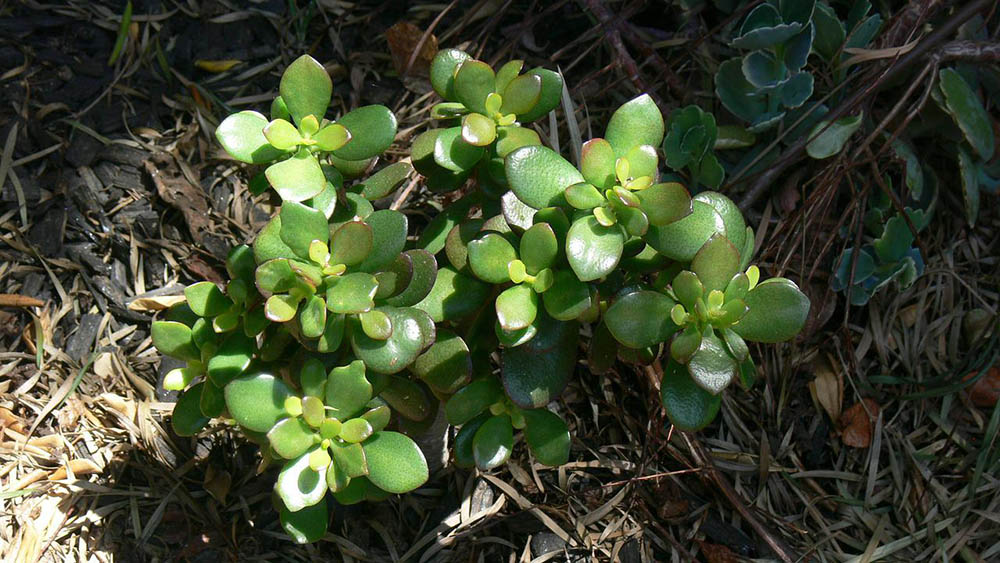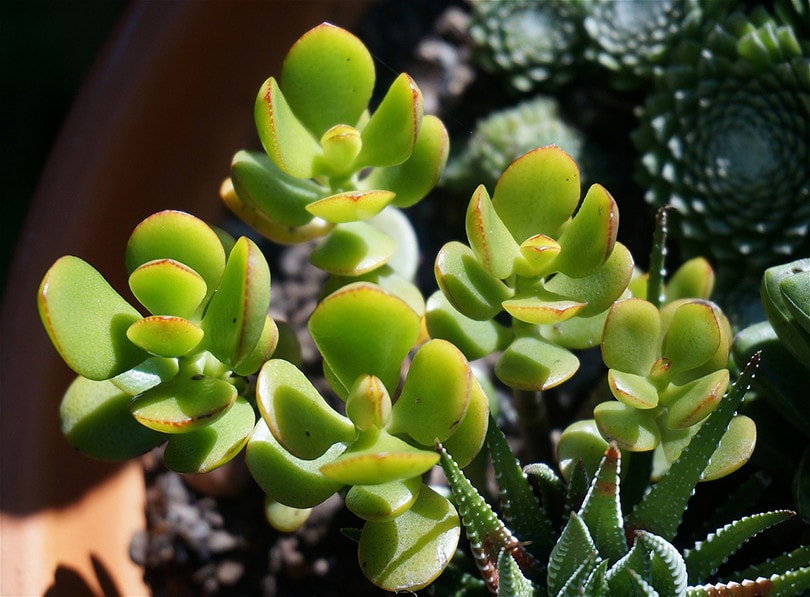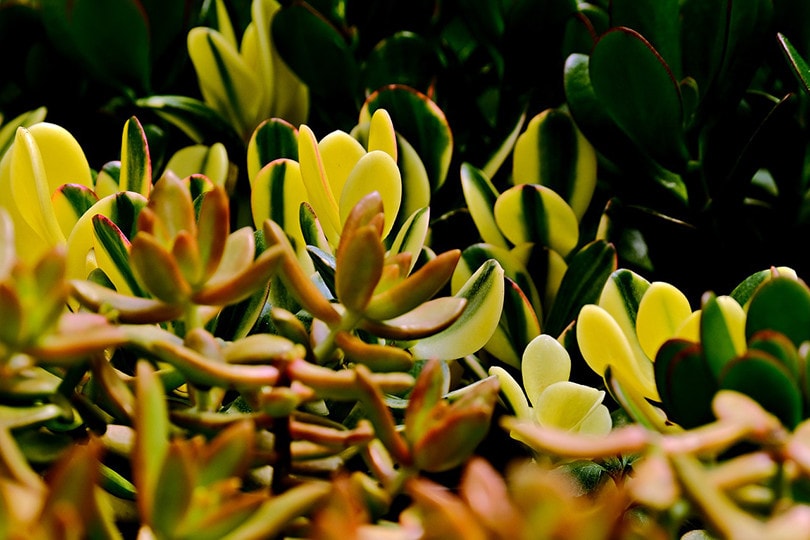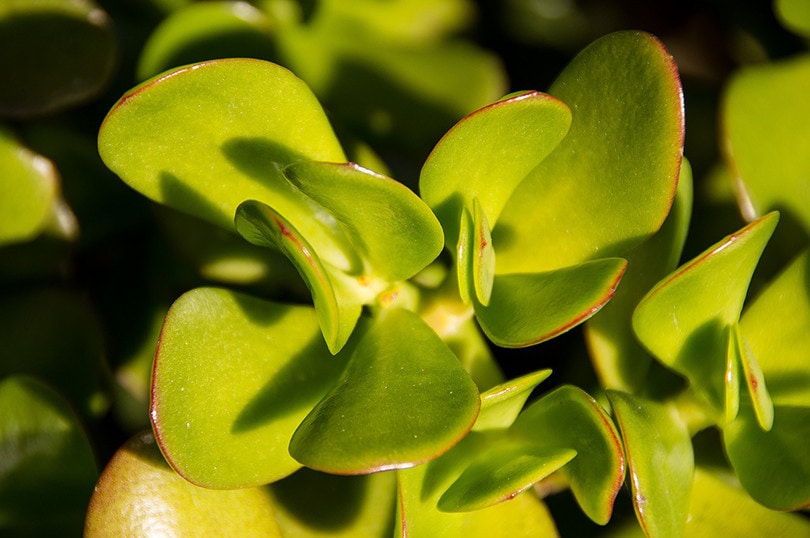How Much and How Often to Water Jade Plant
-
Pete Ortiz
- Last updated:

The jade plant, also known as the money plant, is a go-to indoor plant in the States. Native to Africa, Crassula ovata is a relatively small yet incredibly sturdy succulent. And it’s fairly easy to grow indoors.
But how often do you water it, though? How much moisture does it need to thrive? Water it moderately, once in 2–3 weeks, and only when the top 1–2 inches of soil are completely dry.
This will vary, however, depending on the climate, humidity levels, exposure to the sun, the soil type, and the fertilizer product(s). The time of the year will also greatly affect the jade plant’s watering needs. So, if you want to take proper care of your silver dollar tree, here’s what you need to do!
| Botanical Name | Crassula ovata |
| Soil Type | Well-drained, sandy, loamy, rocky, low-fertility |
| Soil pH | 6.0–6.5 (slightly acidic) |
| Sun Exposure | Full sun/partial shade |
| Watering Requirements | Moderate, once in 2–3 weeks |
| Temperature | 50–75° Fahrenheit |
| Humidity Levels | 30–50% (Indoors) |
| Hardiness Zone | 9a–12 USDA |
| Blooming Time | Late winter to early spring |

The Jade Plant
Key Properties and Characteristics

The money tree/lucky tree isn’t particularly big (18–30 inches tall) and will effortlessly fit in an average-sized container. As a succulent, it has thick branches and leaves. Mostly green, they can have a yellowish hue. When exposed to scorching sunlight for a long time, the leaves (or, rather, the tips) tend to turn red. So, make sure to control the amount of sun the plant gets throughout the day.
As for the flowers, they can be white or pink. The blooming period is January–February, lasting through most of March. One of the best things about the jade plant: it is very easy to grow. You won’t need to be a seasoned gardener to see it flourish. Thanks to its rough-tough nature, it survives in most indoor environments. And while it’s not an instant eye-grabber like some other indoor plants, it is still very beautiful.
How Much Water Does This Plant Need?
The most important thing to remember is that the money tree is a succulent. Just like most cacti, it only requires small amounts of water to grow and flourish. This is especially true for the winter days when the sun is scarce. Overwatering is the biggest enemy of the jade plant. If you add too much water to the pot, the roots will rot. In the worst-case scenario, the leaves will turn yellow and fall, while the plant will wither and die.
Again, the colder it is outside, the less water the lucky tree needs. That doesn’t mean you shouldn’t water it at all, of course. Low moisture levels can be quite dangerous as well. It’s all about finding the right balance and sticking with it. Remember: as a succulent, it stores water in the stems, leaves, and roots. Give the soil enough time to dry between waterings. Follow this simple rule, and overwatering won’t be an issue.
Once a Week or Once a Month?

So, exactly how often should the jade plant be watered? To play it safe, water it once in 2–3 weeks in a plastic pot. Do it once in 2 weeks in a clay pot (or when growing it outside). Use your fingers to check on the soil. If the top 1–2 inches are still wet (slightly moist), don’t add any water. During the hot days, consider watering the money tree every 1–2 weeks. But, again, run a quick “inspection” on the container. Chances are, the soil is still wet.
Another key factor when taking care of the jade plant is to use the deep watering technique. That means the soil has to be soaked at least 8–10 inches deep. The fall–winter period is when the jade plant goes dormant. Just like most cacti and succulents, it will grow slower as temperature levels and natural light hours drop. When it gets really cold and dark, the plant will practically stop growing, which is totally normal.
Sun Exposure: Full Light vs. Partial Shade
Ideally, the jade plant requires 4–6 hours of exposure to direct sunlight during the day. But, it won’t fade or stop growing in partial shade. As long as it gets enough light, you won’t have to worry about anything. Besides, as mentioned, too much sun can literally burn the leaves. Does the temperature matter when growing the money tree? Yes, it does, and both for indoor and outdoor plants.
The ideal daytime temperature for it is 65–75°F. When the sun sets and it gets dark outside, 50–55°F will be just right for the jade plant. Please keep in mind that it’s hardy in USDA zones 9a–12 and won’t be able to survive in frost. The money tree easily handles dry, desert-like environments but has little to no resistance to below-average temps.
And What About the Soil?
Good drainage, a porous substrate, and sandy, rocky, and loamy soil are the perfect combination for the jade plant. It’s a highly resistant and resilient plant that flourishes in poor soil conditions. However, if the drainage system in the pot/container doesn’t work properly, you’ll run the risk of overwatering the plant even if you water it moderately. Make sure the drainage holes aren’t clogged!
The money tree will benefit from adding small portions of a fertilizer product once in 3–4 months, mixed with a cactus mix. If it’s the active growing season, try fertilizing it once in 2–3 months to keep nutrient levels in the soil high. The plant will make do without the fertilizer, of course, but a little bit of it can go a long way.
Propagation: Why Is It Important?

The lucky tree is one of the easiest plants to propagate. All you have to do is clip a stalk or two and plant it in a separate container. Or, you can use a fallen leaf. Do you want every single room in your home to have its own jade plant? Then propagation is the way to go! Also, by having multiple money trees in the house, it will be much easier to figure out the right humidity levels, temperature, and sun exposure.
If one of the plants is growing slower, has yellowish leaves, or doesn’t bloom for 5+ months, that means the climatic conditions are all wrong. Just don’t forget to give the leaves some time to dry, callus over, and heal before you plant them in soil. Expect them to take root in 3–4 weeks after planting. Another big pro of propagation: if you have more money trees than you can handle, they will serve as perfect gifts!
Jade Plant: Common Uses and Benefits
In many cultures around the globe, the money tree is used as medicine to treat diabetes, an upset stomach, and epilepsy. For example, in China, the jade plant tea is a common remedy against high sugar levels. Many African tribes also use it as a medical plant. It’s great at lowering VOC levels, improving the air quality, and boosting humidity. With that said, do protect your hands from its sap, as it can make the skin inflate.
While the plant’s toxicity levels are quite low, you can still get dermatitis from direct contact. Domestic animals (pets, dogs, and horses) are more vulnerable to the jade plant’s sap. Make sure to keep your pets away from the jade plant! In contrast to many succulents, the money tree isn’t edible. You could technically eat it, but that will cause diarrhea, intestinal irritation, and nausea. Besides, it doesn’t really taste like much.
Conclusion
And there you have it—our guide to watering the jade plant. Although it’s very common in American households, we don’t always take proper care of it. And, it’s often the watering habits that we need to “fine-tune” a bit to ensure proper growth. Once in 2–3 weeks is more than enough for this plant. It will grow rapidly if you keep humidity levels below 60% and plant the money tree in a well-draining pot.
Also, see that it gets enough sunlight during the day to cultivate growth. The jade plant is quite tough and resilient. It can survive in partial shade and poor soil and has an extended blooming time. So, water it adequately, and let’s hope it brings you wealth!
See also:
- MissouriBotanicalGarden – Crassula ovata
- TheSpruce – All About “Watering Deeply”
- EPA – What are volatile organic compounds (VOCs)?
- Jade plants benefits and how to take care of them
- Succulent Dormancy: What you really need to know
- Wisconsin Horticulture – Jade Plant, Crassula ovata
- NYBG – Jade Plant (Crassula ovata)
- Edu – Jade Plant
- Almanac – The Jade Plant
- Wikipedia – Crassula ovata
Featured Image Credit: PastorG, Pixabay
Contents

